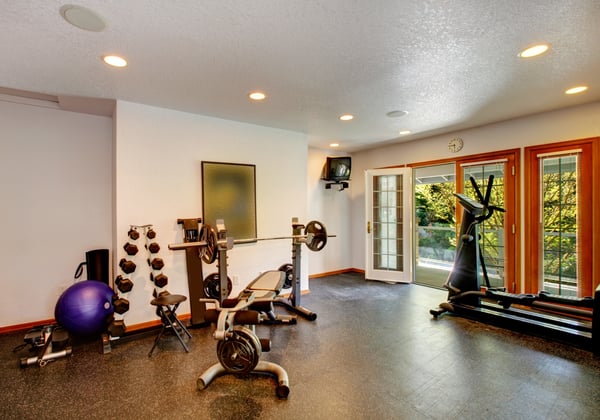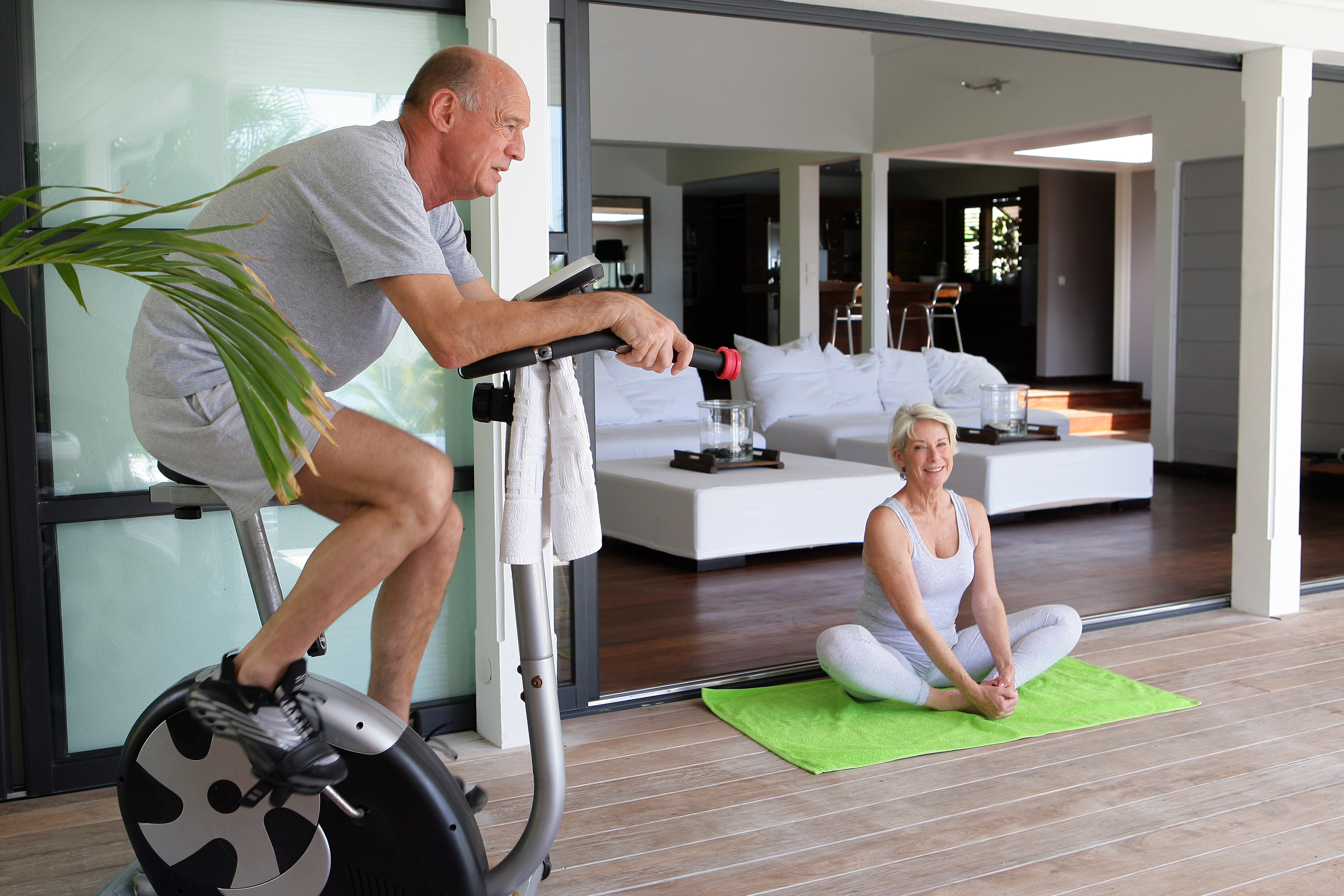Bringing the Fitness Studio Home—with MrSteam
How many times have you planned to get out to the gym, just to have life get in the way? You may be shocked to learn that Americans spent $19 billion on gym memberships this past year—and that 67% of people who are members of a gym never end up going. When you consider that the average cost of a gym membership is $58 per month, you might want to reconsider—especially if you find you’re part of that group that never walks through the gym’s front door.
How much easier would it be—and how much more likely are you to actually put in the time exercising—if your fitness studio was right in your own home? All the excuses (the weather’s bad, I look awful in my gym clothes, the kids are home on vacation) instantly melt away. And consider how much more control you will have—over the thermostat, the music being played, even when you can access that last piece of equipment in your routine.
There are many benefits of a home gym:
- You can tailor it to suit your particular exercise needs, your budget, and the space you have to work with.
- You pick the time of day you want to work out, without having to leave home to do so.
- You’ll save time. Going to a gym means more than just workout time. It also includes travelling both ways, often changing clothes before and after, as well as taking time to shower. And if your gym is popular, you may have to circle the parking lot a few times and wait for specific pieces of equipment.
- The long-term savings will add up. Yes, equipping your home gym requires an initial outlay, but if you calculate how much you’re saving in gym membership fees, as well as gas, that investment will pay off in the long run.
Finding the Right Room for Your Fitness Studio
It’s important to consider the best place for your home gym, especially if your space is limited. Often, home fitness studios have to be incorporated into multi-use rooms. Here are some factors to keep in mind as you plan the best area to store and use your equipment:
- Who else uses the room—and when? If your home gym is in the family den, for instance—a popular choice as it offers that all-important television screen—you may find yourself fighting with your spouse, children, or roommates over the use of the room. Ideally, you want to find a low-traffic area, such as a spare room, basement, or part of a garage, somewhere that you can make uniquely your own. It helps, too, if people aren’t walking through when you’re exercising, potentially distracting you or making you feel self-conscious. If you can’t, of course, you may need to compromise with the family and establish a few ground rules from the start.
- How much room do you need? Some home fitness studios use minimal equipment, such as mats, free weights, and exercise bands, along with enough space to move. But if you are planning on various large pieces of exercise equipment, including stationary bikes, treadmills, even a home-gym system that allows you to do a wide variety of strength-building exercises by adjusting cables, adding weights, or using your body weight, your home gym may require a room of its own.
- Consider the height of the ceiling and the composition of the floor. You should have enough room to be able to move freely, especially if your routine includes jumping. You don’t want to bang into hanging lights or put a hole through a low ceiling. And you don’t want to potentially damage your knees if your floor is made of wood or concrete. If it is, you might want to invest in some rubber mats or rugs. Just make sure they won’t slide as you move!

- Think of ways the space can motivate your workouts. We’ll talk later on about one sure-fire reward for all of your hard work, but you may also want to consider what will make the room special to you—whether that is a specific color scheme, a full-length mirror, certainly a way to play DVDs or music. An ideal space has natural light streaming through, though good lighting helps if windows are not possible. And green plants will bring in additional sources of oxygen. (You’ll be breathing hard, after all!)
- Plan organized ways to store all that equipment! This is important even if the room is exclusively used as a fitness space. Consider shelving where you can store free weights and dumbbells, and corners where you can roll that stability ball, baskets, or storage chests for foam rollers. You want to avoid clutter, especially as stumbling over a misplaced piece of equipment can cause an accident.
Of course, you don’t have to buy every piece of equipment on day one. There are some inventive ways to use found objects as exercise equipment—like water bottles as weights, or existing furniture to help balance and move.
What to Focus On
Experts say that you should focus on three general aspects of fitness in your home gym—strength, endurance, and flexibility:
- Muscular strength is important to strengthen the ‘connective’ tissues, such as ligaments and tendons, preserving bone density so you increase your resilience to pain and injury. Studies have also shown that a higher muscle mass helps to maintain your metabolic rate as you age, lowers the risk of diabetes, and can help you keep your blood pressure in the right range. If you want to invest in a major piece of equipment, a resistance machine like the ones seen in your local gym can help. But hand-held weights or homemade weights—such as plastic soft drink bottles filled with water or sand—may work just as well. Resistance bands are another inexpensive option. Your own body weight counts, too, and come into play with push ups, pull ups, abdominal crunches, and leg squats.
- Endurance is gained through aerobic or ‘cardiovascular’ exercise. This helps your heart—studies show that even 30 minutes walking a day can lower bad cholesterol (LDL) levels and reduce blood pressure—and the energy use can help you lose weight and keep it off. Aerobic activity includes any physical activity that uses large muscle groups and increases your heart rate. Home gym options include aerobic videos, treadmills, stationary bikes, and elliptical trainers.
- Flexibility means being able to move your joints and muscles through their full range of motion. As we age, our flexibility declines as collagen fibers within the muscles stiffen. Stretching regularly helps ensure that we avoid growing stiff and immobile, with short, tight muscles. Stretching after intense exercise, when the muscles are warm, will help, as will a session of yoga. You may want to invest in a yoga mat and some instructional DVDs to help motivate you, especially if you are new to this type of exercise.
Your Reward? Finish Off with Steam!
We promised you a reward for all the hard work you will do in your home fitness studio—and what better way to finish off a workout than with a steam shower? In addition to being a great daily indulgence, steam offers the following health benefits to really polish off that exercise session:
- Increases blood circulation, helping keep your heart healthy
- Boosts metabolism, one of the major reasons to exercise
- Reinvigorates tired muscles, removing lactic acid from overworked muscles—helping you recover more quickly from an intense workout
- Increases muscular flexibility—allowing your stretching sessions to be more effective
- Burns an average of 150 calories in a 15-minute steam bathing session at 114° F (so even after your workout, you can continue to shed calories!)
- Helps you relax and reinvigorate after exercise
Adding a steam component to your home gym makes perfect sense—and is certainly something to look forward to during your more frequent workouts, as you grow healthier in the comfort of your own home!

 SEARCH
SEARCH
 FIND A DEALER
FIND A DEALER






